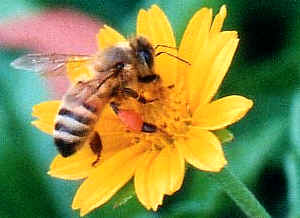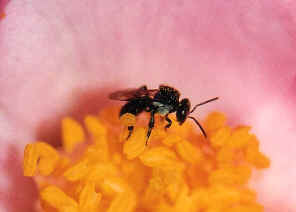Family APIDAE - Social Bees
Order Hymenoptera
This page contains pictures and information about Bees in Family APIDAE that we found in the Brisbane area, Queensland, Australia.
-

- They also have long tongues which allow them to reach the nectar in tubular flowers. Of course they feed on shallow flowers as well. The bees in this family carry the pollen in corbiculae (the smooth and enlarge region on the hind leg, with a fringe of hairs they form a pollen basket).
- The Apidae and Anthophoridae are close relatives and sometimes they are put in one family under Apidae.
The Apidae family includes the famous Honey Bees and the Australian Native Stingless Bees. They are the highly social bees. There are also the solitary and communal species in this family. Their nest sites include ground and tree holes
Tribe Apini
- In this tribe there is only one introduced species in Australia.
- Honey Bee



- Apis mellifera Body length 15mm
- Honey Bees are introduced domesticated insect, however we found many feral colony in Brisbane. They are social insects live in very large colony. Worker bees are golden brown in colour with hairy legs, thorax and head. For more information about Honey Bees, please click on here.
Tribe Meliponini
- They are small black hairy bees. Different species look very similar.
- Native Stingless Bee



- Trigona carbonaria, body length 4mm
- Stingless Bees are Australia Native Honey Bees. They also known as Sugar-bag Bees and Sweat Bees. They are common in Brisbane. They are small in size and do not string. They are black in colour with hairy extended hind legs for carrying nectar and pollens. They are social bees living in large colony. Their nest usually built inside living or dead tree trunk. More information can be found in the Stingless Bees page.
- Reference:
- 1. Native Bees of the Sydney region, a field guide - Anne Dollin, Michael Batley, Martyn Robinson & Brian Faulkner, Australian Native Bee Research Centre.
- 2. Northern Territory Insects, A Comprehensive Guide CD - Graham Brown, 2009.
